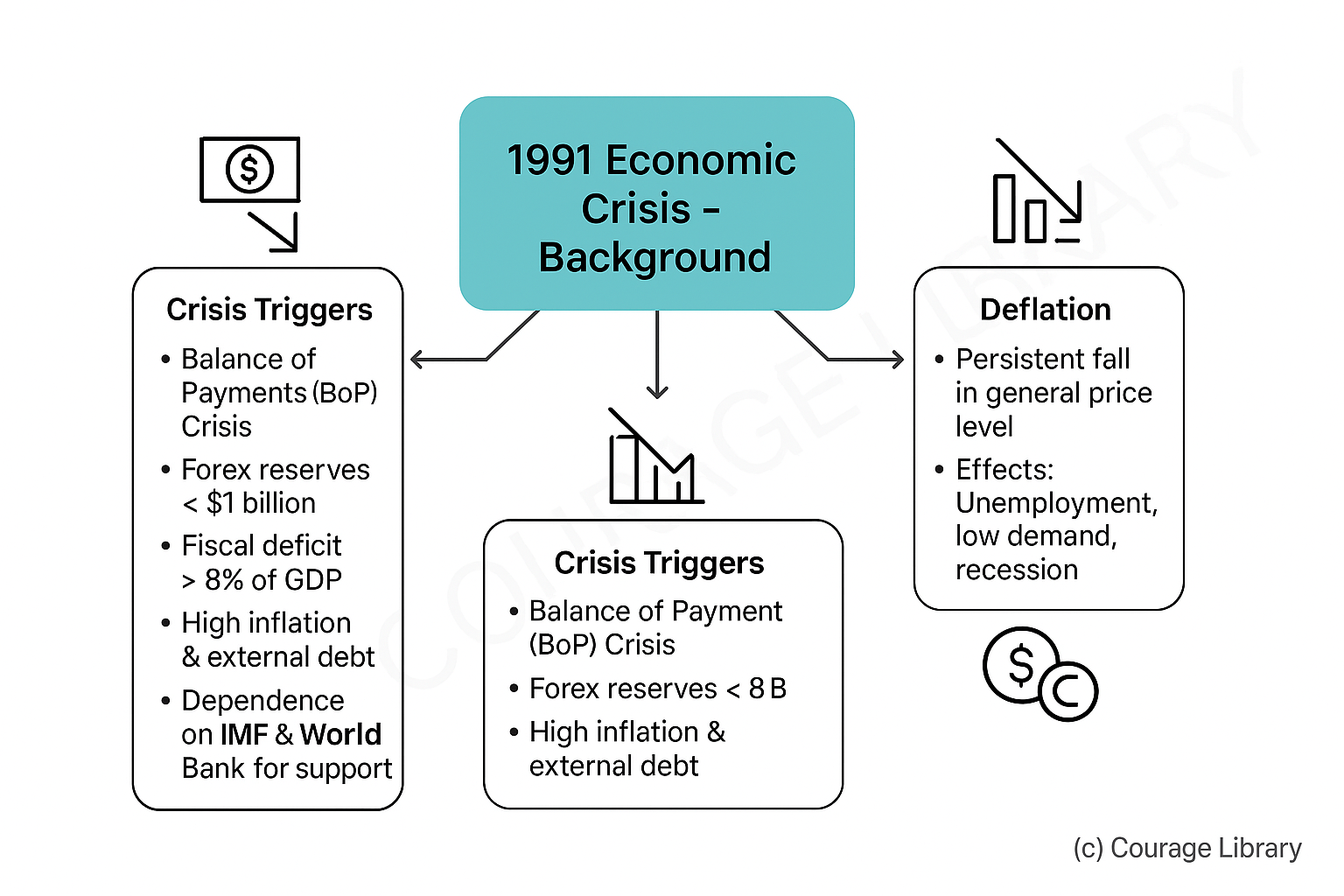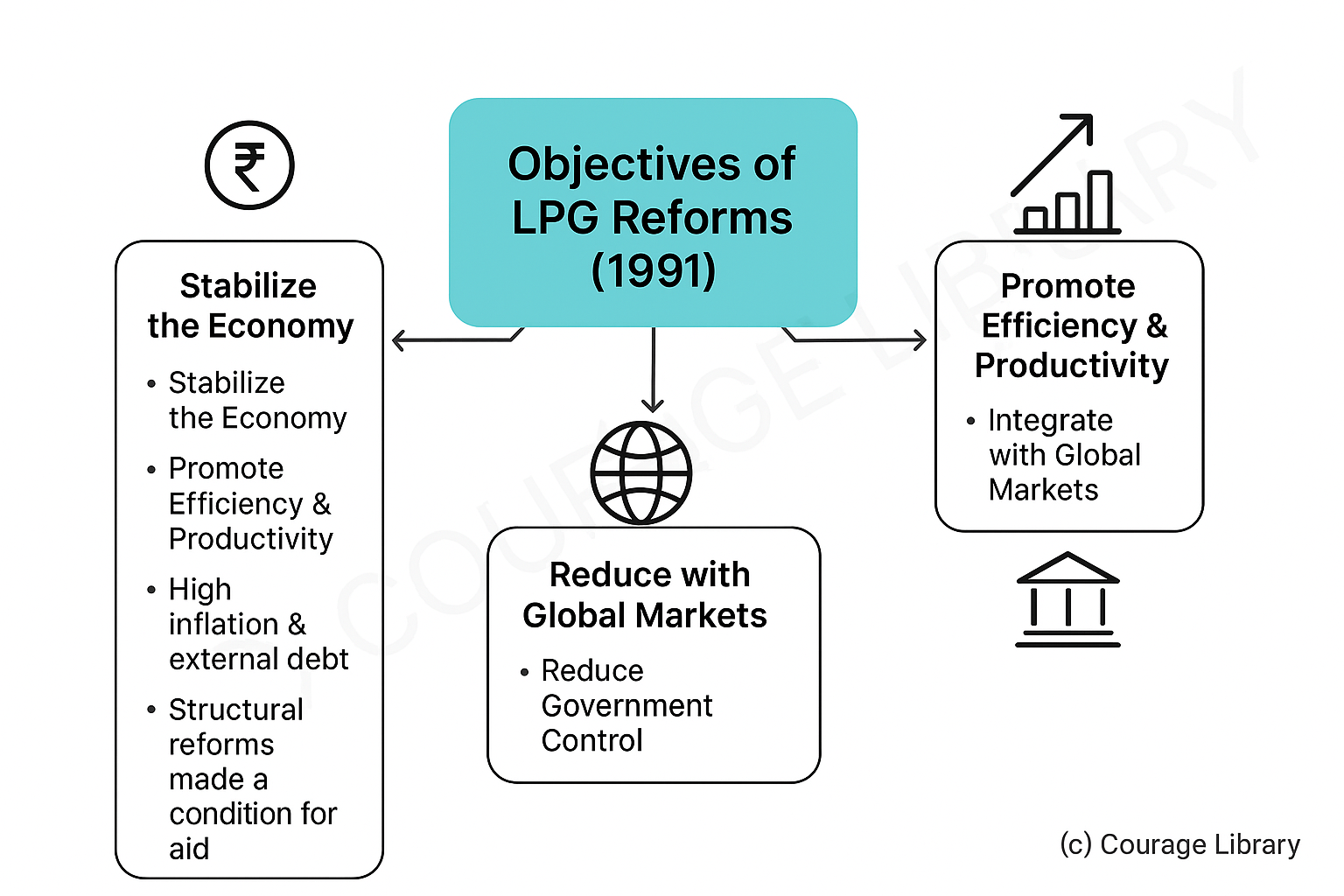SSC CGL - Detailed Guide 2025
Self-Paced Course

Economic Reforms in India
Reference: Lucent GK, NCERT Class 6–12
Liberalisation, Privatisation, Globalisation (LPG) – 1991 Reforms
Background:
- Triggered by the 1991 Balance of Payments (BoP) Crisis:
- Forex reserves fell below $1 billion
- Fiscal deficit over 8% of GDP
- High inflation and external debt
- IMF & World Bank support conditional on structural reforms.

Objectives of LPG Reforms:
- Stabilize the economy
- Promote efficiency and productivity
- Integrate with global markets
- Reduce government control

Liberalisation
Freeing the economy from excessive government control.
| Key Areas Reformed | Description |
|---|---|
| Industrial Licensing (License Raj) | Abolished for most industries (except 18 strategic ones) |
| Foreign Investment | Automatic approval for FDI in many sectors |
| Foreign Exchange | Rupee devaluation; current account convertibility |
| Trade Policy | Import quotas removed; tariffs reduced |
| Financial Sector | Deregulation of interest rates; RBI autonomy improved |
Privatisation
Involving private sector in ownership and management of enterprises.
| Key Measures | Description |
|---|---|
| Disinvestment | Selling government stake in PSUs |
| Public-Private Partnership | Promoting joint ventures between govt and private players |
| Deregulation | Entry of private players in telecom, aviation, banking, etc. |
Globalisation
Integrating the Indian economy with the world.
| Key Aspects | Description |
|---|---|
| FDI & FII | Greater access to foreign capital |
| WTO Membership | Joined in 1995; commitment to fair trade practices |
| Exports/Imports | Liberalised trade policies; Special Economic Zones (SEZs) promoted |
| Outsourcing & IT Boom | India emerged as global IT/BPO hub |
Result: Faster GDP growth, better forex reserves, reduced poverty — but also increased inequality & dependence on global markets.
New Industrial Policy – 1991
Announced: July 24, 1991
Main Features:
| Area | Reform Measures |
|---|---|
| Industrial Licensing | Abolished for all industries except 6 strategic sectors (e.g. defense) |
| Public Sector | PSU monopoly removed in non-strategic areas |
| Foreign Investment | Automatic approval for FDI up to 51% in select sectors |
| MRTP Act | Threshold asset limit of firms removed |
| Small-Scale Industries | Investment limit enhanced; easier credit access |
Aim: Encourage competition, innovation, and private sector participation.
Strategic Sectors Reserved for Public Sector (now reduced further):
- Atomic Energy
- Railways
- Defense
- Minerals (like uranium)
- Oil and petroleum
- Space
Impact:
- Boost to entrepreneurship and investment
- Greater foreign tech and capital inflow
- Shift from commanding heights to facilitator government role

Disinvestment Policy
Definition:
- Selling government's equity (ownership) in Public Sector Undertakings (PSUs) to private investors.
Objectives:
| Objective | Description |
|---|---|
| Improve efficiency | Encourage professional/private management |
| Reduce fiscal burden | Mobilize resources for other public expenditure |
| Encourage competition | Break PSU monopoly, foster a level playing field |
Methods of Disinvestment:
| Method | Description |
|---|---|
| Minority Stake Sale | Govt retains majority control (>51%) |
| Strategic Sale | >51% stake sold along with management control |
| IPO/FPO | Shares offered to public through stock exchanges |
| ETF Route | Exchange-Traded Funds (e.g. Bharat 22 ETF) |
Key Agencies:
- Department of Investment and Public Asset Management (DIPAM)
- NITI Aayog gives strategic sale recommendations
Recent Trends (2020s):
- Major disinvestment cases: Air India (to Tata Group), BPCL, LIC IPO
- Strategic disinvestment target fixed annually in Budget
Developed By Jan Mohammad
Next
Start Your SSC CGL Journey Now!
Join Courage Library to experience disciplined study and expert support.
Be a Couragian!